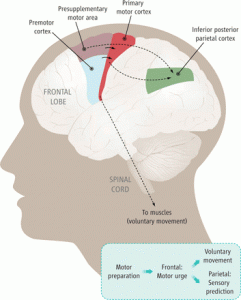
What’s Controlling You? Intent vs. Action
 Imagine you are playing a game of tag. As you run around trying to tag a friend, you accidentally push them into the ground. You are immediately apologetic because you only intended to tag them. However, they interpret your action to mean that you intended to cause them harm. Everyday situations like this occur in which humans intend to perform one task however, the body performs an action opposite to what you wanted. What causes this disconnect between our intent and our resulting action? Why are intent and action connected as so?
Imagine you are playing a game of tag. As you run around trying to tag a friend, you accidentally push them into the ground. You are immediately apologetic because you only intended to tag them. However, they interpret your action to mean that you intended to cause them harm. Everyday situations like this occur in which humans intend to perform one task however, the body performs an action opposite to what you wanted. What causes this disconnect between our intent and our resulting action? Why are intent and action connected as so?
Intent vs. Action
First, let’s define action and intent. Action is defined as “our way of interfacing with the world, and our means of putting all our goals and desires into practice” (Ward 2015). Intent is defined as “the state of mind in which an act is performed” (Webster). Just from the definitions we can see that these processes rely on one another quite a bit.
Emerging Research
Recent research on robotic prosthetics has shown that these two terms are definitely intertwined. Scientists at the California Institute of Technology have made it possible for quadriplegics to move robotic prosthetics by placing electrodes on the area of the brain that controls movement (Alford, 2015). More specifically, the electrode was placed in the region of the brain that holds the intent to move. Once the subject thinks “I want to grab this cup”, the robotic arm will move to follow this intention. The movements were generally fluid and the subjects were able to perform expert tasks such as a game of rock, paper, scissors. This experiment helped to solidify that intention and action are on the same pathway.
Check out this video of a similar experiment at Johns Hopkins University

The previous experiment and the connection between intent and action can be explained through the term volitional motor movement. This term is a broad name for the everyday activities humans complete that are based on free will (Medina, 2011). Free will categorizes as actions we choose to perform, or intent. Volitional motor movement explains that every action we perform first goes through the pathway that determines from our intentions what action will be taken. It was proven that the parietal lobe carries the conscious experience of intention. Which means that when this area is stimulated you will have the desire to perform some action. The parietal lobe contains much of your information on touch, multimodal processing, language comprehension, and spatial awareness. It makes sense that when this area is stimulated you would want to perform an action. Additionally, when the presupplementary cortex is stimulated, the urge to perform an action comes with it. The presupplementary cortex is in front of the supplementary motor area where the ability to perform learned sequential actions (ex. playing a musical instrument) is stored (Ward, 2011). While the pre-SMA works to help you learn new sequential procedures, not perform movements (Hikosako et.al., 1996). The urge to complete an action when the pre-SMA is activated comes from that learned experience that you should perform an action when presented with certain stimuli.
Disconnection?
The opening paragraph described a clear disconnect between your intent and the action that occurred. The explanation can be very simple. Our minds work to follow our intentions however, the mind only looks to achieve the goal you intended on fulfilling. For example, you may intend to reach for a glass of water but your intentions do not “tell” your actions how to achieve this goal, your body just knows a series of steps to reach this goal. Those series of learned movements stored in the SMA could result in you doing something you may not have intended. For example, instead of reaching for the water to pour in your glass , you reach for a carton of juice. It may be a learned action to consistently reach for juice instead of water so your bodies performs what action it knows so well. This does not mean you intended to do one thing over the other but your body had a learned process that did not connect with your intent.
Conclusion
Overall it seems as though intent and action operate on a pathway together. If you are planning to make a right turn, your body in turn will act to do so. The intention/goal comes first in order to perform the action. Occasionally, there may be a slight discontent however, your body always realizes the ultimate goal of completing an action. Intent and action are definitely intertwined when it comes to determining your movements. Will your body always do what you want? No, but your desires always has the first say.
Citations
Alford, J. (2015). New system allows paralyzed man to control robotic arm with his intentions. Retrieved from http://www.iflscience.com/brain/new-system-allows-paralyzed-man-control-robotic-arm-his-intentions
Hikosako, O., Miyauchi, S., Putz, B., Sakai, K., Sasaki, Y., & Takino, R. (1996). Activation of human presupplementary motor area in learning of sequential procedures: a functional MRI study. Journal of Neurophysiology, 76(1), 617-621.
Medina, J.J. (2011). The neurobiology of conscious intent. Psychiatric Times. Retrieved from http://www.psychiatrictimes.com/articles/neurobiology-conscious-intent
Ward, J. (2015). The student’s guide to cognitive neuroscience. New York: Psychology Press
